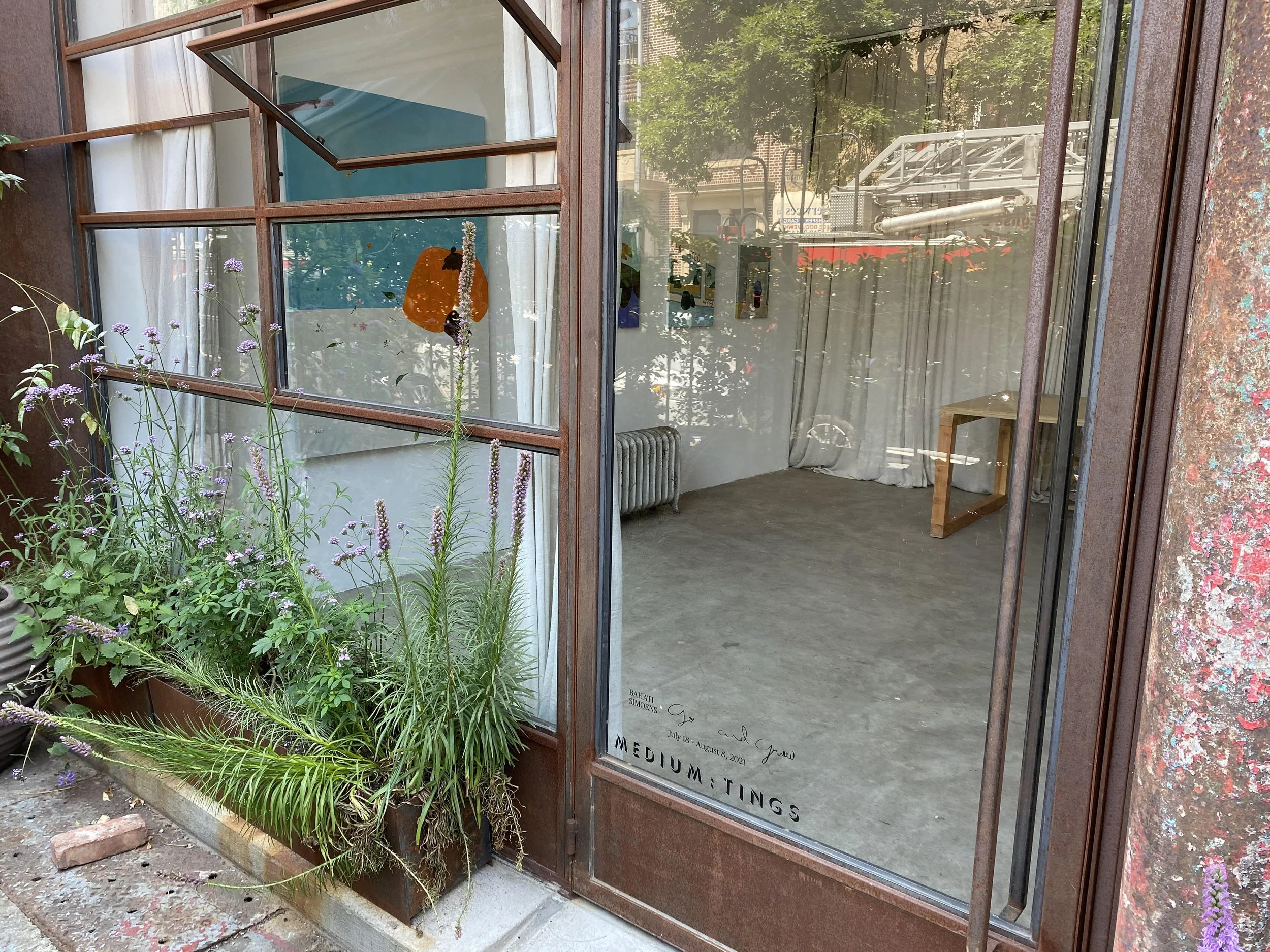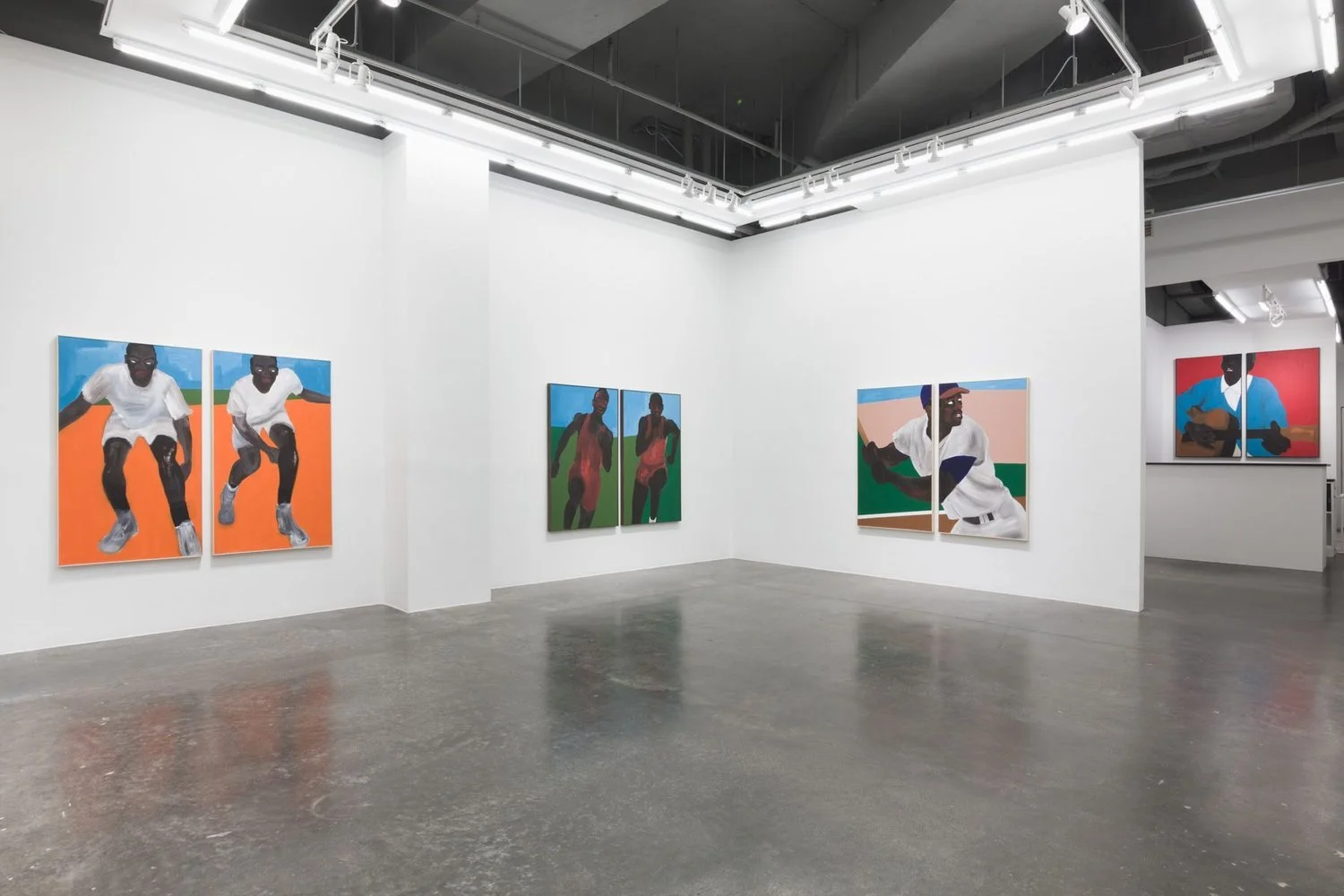Exterior view of Bahati Simoens: Go and Grow, 2021, photo credit: Medium Tings
Medium Tings
Medium Tings (MT) is a gallery and project space for art and dialogue, centering around black artists. Conceived and founded by Stephanie Baptist, Medium Ting's inaugural space was a gallery housed on the top floor of a Brooklyn brownstone from 2017-2019. The gallery's pillars of focus are exhibitions, public art, collaborations, and a retail shop to encourage experimentation, sustainability and cultural creation of limited goods, art objects and books. MT has collaborated with Anna Zorina Gallery, Art in Ad Places, Times Square Arts (the public art program of the Times Square Alliance), and 92Y, a non-profit cultural and community center.
Installation view of Alvin Armstong: To Give and Take, 2021, photo credit: Stan Narten c/o Anna Zorina Gallery
Interview with Medium Tings Founder Stephanie Baptist
Hi Stephanie! Can you tell us about your background as a commercial photography agent, editor, and Head of Exhibitions at Tiwani Contemporary in London? How did these experiences lead to the founding of Medium Tings?
I worked with commercial photographers for about 5 years before moving to London to pursue an MA degree in Arts Administration and Cultural Policy. After a year and a half exploring London’s contemporary art scene, I was introduced to the founders of Tiwani Contemporary, a new gallery that was planning to work exclusively with contemporary African artists.This chance introduction was at a pivotal time in my practice and blossomed into an exploration across curation, book editing and programming for three years. It is safe to say that London definitely planted a seed for what could be possible, eventually leading to the development of Medium Tings.
From 2017 - 2019, your inaugural exhibition space existed in the living room of your Crown Heights apartment. What inspired this decision? Have you always been drawn to apartment galleries or other alternative spaces?
In London, I was drawn to a lot of alternative spaces (ironically none of them were apartment galleries) as the city was really brimming with a lot of creativity, ranging from art platforms housed in parking lots to film festivals held in parks on rooftops! When I came back to NYC, I noticed that the landscape for this type of creativity was rather limiting, especially for Black artists. In 2017, I was living in Brooklyn on the top floor of a brownstone and a chance conversation with a dear friend led to the decision to convert my living space into an experimental gallery. At the time, I saw it as an incubator project to curate ideas in 500 SQ FT of space without the overhead of a brick and mortar.
How did this space - less formal and predictable than a traditional white cube - affect the vibe of openings or the way visitors interacted with the work? Did living with the work change your relationship with it?
I held most openings on Sunday afternoons which allowed for an easy weekend energy as well as intentional crowds eager to see art. Many people in the community (and at large) really responded to having art in a living room. I believe there was a feeling of comfort, relatability and ease walking into a space that everyone is familiar with. Living with art definitely changed my perspective. I had begun my art collection slowly a few years prior and living with the work encouraged me to be more of an active supporter. I have many fond memories of chatting about life with strangers, as I view art as a series of conversations and in order to become a part of the conversation, you have to sit with it awhile.
I know you’re currently based in Brooklyn. In what ways has this community supported your vision? What aspects have been more challenging?
Honestly speaking the most challenging thing about running a gallery is having enough funding to execute quality ideas! My community has been extremely supportive in so many ways by attending openings, purchasing art and even amplifying the work that we do across their own platforms and in the media!
Installation view of Milo Mattieu and Austin Wills: Beauty in the Unknown, 2018, photo credit: Jackie Furtado c/o Medium Tings
How have the limitations posed by the pandemic (and desire to stay connected) shifted your perspective or priorities for Medium Tings’ programming during this time?
I have never seen Medium Tings as a static endeavor. The ultimate goal is for it to always be evolving and changing in some shape or form. The pandemic was definitely challenging but we had been developing some digital initiatives just prior to the pandemic, so our pivot into this area wasn’t too difficult. Without the ongoing overhead of a physical space we pushed ourselves to host a few physical exhibitions (safely) during this time, as we understood how desperately the community and artists need to have in person engagement. The pandemic has also taught me the importance of slowing down – as I have been playing around with the notion of ‘slow art production’ as in taking time to read, engage, reflect and then produce ideas. The pandemic forced me to prioritize essentials first , so that I can operate from a restorative state of mind, instead of the usual need to activate as much as possible.
What is your approach to building a robust community of artists? How do you cultivate an audience, while fostering connections between artists and collectors?
We spend time growing our mailing list and engaging audiences via email and word of mouth. Meeting with artists in person via studios, attending exhibitions, participating in review panels for residencies and universities, all come together to help build community. We also try to cultivate audiences via our social media platform, but are aware that there is a lot to compete with in this realm. We are working on new offerings for budding collectors as we know that this is a key component to an artist's growth and development.
Medium Tings is dedicated to amplifying the voices and narratives of black artists, while contributing a platform for experimentation and dialogue. Can you tell us more about your mission to ambitiously address this need and create opportunities?
Artists need the ability to stretch themselves and their practices in a multitude of ways. As a platform, we embody the ethos to remain fluid enough to evolve just as much as artists and are fine with being a multi-hyphenate: gallery, shop, incubator, etc in order to meet the growing demands of artists. Our future goals continue to include publishing, as well as more public art initiatives as well.
I know you’re committed to providing access to emerging and new collectors as well. Can you talk a bit about this philosophy?
We believe that everyone has the ability to become collective stewards of the arts and want to remove some of the barriers to entry. We offer payment plans as well as varying price points of entry to include anything from an art book, limited edition print to a unique piece of art.
We are also working on educational offerings to help inform and mitigate the stress around starting a collection. We want to empower everyone with the knowledge that there is no wrong way to start your collection. It really starts with a passion and desire to learn.
Installation view of Arielle Bobb-Willis: Ever-Lucid, 2018, photo credit: Jackie Furtado c/o Medium Tings
Go and Grow marked the debut solo exhibition of Bahati Simoens in the US. Can you share some insight into her practice and these captivating paintings of “imaginary figures culled from childhood memories in Burundi, as well as the complex landscape of African diaspora histories”?
Bahati Simoens is a Belgian Congolese artist who has a really strong point of view. Drawing inspiration from her heritage and the everyday, Bahati inserts her own emotions into these imaginary figures which represent her love of the black body. These bodies take up space metaphorically and physically, as they occupy most of the canvas and are presented with faceless small heads. This is a deliberate choice, as this allows viewers to spend more time with the vibrant color palettes, lush environment, or descriptive features such as body tattoos to encourage individual interpretations. This marked the artist’s debut solo exhibition, as well as our first opportunity to present an internationally based artist.
You’ve also partnered with other institutions as a guest curator, notably for Between Land at Sea at 92Y and To Give and Take, Alvin Armstrong’s solo exhibition at Anna Zorina. Can you talk more about these collaborations and Medium Tings as a roving project space?
As a roving space, we see collaborations as an integral part of our practice and partner with institutions, people or spaces that share some of our same core values. I was a 2019 Fellow for 92Y and during that year, I developed a really good relationship with the Arts Director. When asked to be the inaugural curator for Works in Progress (92Y’s new digital art platform) we jumped at the chance as this is an organization that continuously finds new ways to support artists during the pandemic, especially since they were unable to host in person exhibitions. We organized Alvin Armstrong’s debut solo exhibition in Fall 2020 and Anna Zorina came to the show. She invited us to curate in her eponymous space last Spring 2021.
Can you share your ideas about the expansive nature of this project? I know your business model is multi-faceted, including site-specific curation, public art, consultation, as well as a retail shop offering limited goods, art objects, and books.
Art is an incredible multitude and we wanted to make sure that Medium Tings embodies this complexity. Everytime we meet with a new artist and start a conversation, we are reminded that there are a lot of ways to work with individuals and start new relationships. We didn’t want to limit our engagement to just exhibitions.
Installation view of Temitayo Ogunbiyi: Nothing in Nature is Private, 2017, photo credit: Jackie Furtado c/o Medium Tings
Are there other artist-run spaces or initiatives that have been influential to you, or that you feel are particularly important right now? What artists are you excited about?
I am excited by the work of many emerging artists such as Danielle McKinney, Siena Smith, Nina Satie, Reggie O’Neal, Erick Medel, and Sydnie Jimenez to name a few. The Underground Museum out of LA is an important part of the cultural landscape - (founded by the late Noah Davis). There is also NXTHVN out of Connecticut, a space founded by Titus Kaphar which offers year long fellowships for both artists and curators.
What’s coming up next for you and Medium Tings?
We have another partnership with 92Y in April which will be a two person exhibition with Dana Robinson and Maya Varadaraj. I am also working towards a few other exciting projects and hope to share with the public very soon!
To find out more about Medium Tings check them out on Instagram or on their website.
Installation view of Marcus Leslie Singleton: Tell Me How Long the Train's Been Gone, 2018, photo credit: Jackie Furtado c/o Medium Tings






